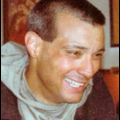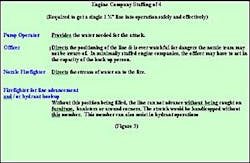An Analysis of Effective Fire Streams - Part 2
The second leg in the fire stream triangle is that of sufficient flow. It is imperative that when the engine company makes its attack, it does so in such overwhelming fashion that the fire is extinguished rapidly. If an engine company chooses to make an attack, it must strive to do it right the first time and eliminate playing "catch-up" later.
For most of the fires we encounter, a 1 3/4-inch handline rapidly stretched to the seat of the fire will accomplish the goal of extinguishment. But, situations exist where this flow is too small and the need for the larger 2 1/2-inch handline is required. When we encounter potentially larger volumes of fire, stretch the 2 1/2-inch line! The 2 1/2-inch line offers great punch and enhances safety when the potential rate of heat release is high. From commercial occupancies to standpipe equipped buildings, the tool of choice is the 2 1/2-inch line. The acronym ADULTS offers an easy way to remember when to use the 2 1/2-inch line (see Figure 1).
What is a sufficient amount flow? The stress associated with being first due and the limited time to do a hundred things at once leaves little time for formulas. Rather, the engine company officer will rely on rules of thumb. For example, a fire in a bedroom of a private dwelling will require a stretch differing from that of a fire in an unsprinklered warehouse.
A good strategy would be to develop a standard flow rate for specific diameter handlines. To get an idea of just how much fire a single flow can extinguish let's look to the National Fire Academy's (NFA) Fire Flow Formula. The NFA's formula, while sometimes said to be too high for a given area, will provide us with an extra cushion of safety. The formula in its most basic form is:
Length x Width of involved area
÷ 3 = GPM required
As an example, suppose a department requires that every engine company be able to put into operation a 150 gpm handline. Using the NFA formula, a 150 gpm flow rate will successfully handle an area of 450 square feet. An area this size may be a couple of bedrooms or a living room in private dwelling. Whatever the example, 150 gallons per minute will only go so far.
Suppose this same department also requires that two engine companies be able to team up and effectively operate a single 2 1/2-inch handline with a 328 gpm flow rate (1 1/4-inch tip). This flow rate, using the NFA formula, indicates that an area of about 1,000 square feet can be successfully extinguished. This area may be indicative of a commercial occupancy or possibly an undivided office space on the upper floors of a commercial high rise building.
While the formulas are of great value for pre-planning, they are of limited effect during the initial chaotic moments of a building fire. It is better to develop standard flow rates for various diameter lines. The members of the engine can then have a general idea of how much fire one line can safely handle.
As an example, in Figure 2, a hypothetical department chooses to staff their engine companies with four members and to equip them with a 75 psi low pressure fog nozzle for the 1 3/4-inch handlines and opted for a 1 1/4-inch smoothbore nozzle for the 2 1/2-inch handline (see Figure 2.)
Effective Reach
The third leg in the fire stream triangle is effective reach. The reach of the stream is directly related to the nozzle pressure and size. Insufficient pressure will provide a limited and ineffective reaching stream.
In addition there are times when nozzles with fixed sized openings, such as smoothbore nozzles or fixed gallonage nozzles, do not receive their rated nozzle pressures and do not flow their identified flow rates. This does not mean an inadequate stream is present. So long as the needed amount of water is properly applied from a safe distance with a nozzle reaction that is safely handled, then an adequate stream is present. With regard to an interior attack, an effective reach can be described as the distance from a where a nozzle team can effectively apply the needed flow rate from an area that maximizes their safety.
Required stream reach may vary from a short distance as in a small private dwelling to a farther distance such as may be found in a commercial building. For typical fires encountered in private or multiple dwellings, a stream that reaches out in a relatively straight line, before gravity starts to pull it down, should reach out to a point of about 40 or 50 feet from the nozzle. This will permit a stream to hit the furthest point in most rooms found in typical private or multiple family dwellings, or smaller type commercial occupancies. Walls, partitions, stock and furniture may prevent a stream from reaching its maximum effective range.
An engine company making its way down a long hot hallway that is able to sweep the ceiling with a stream from 40 to 50 feet away reduces or eliminates the danger of flashover by cooling the combustible gases overhead. As the engine company advances forward to the apartment or room of origin, the reach of this stream will strike, in most cases, all areas from the nozzle team's line of sight.
Longer reaches may be required in larger commercial or industrial buildings, or in high rise office buildings. In these situations the use of master stream appliances may be required.
Engine Company Staffing
A single engine company should be able to put a 1 3/4-inch handline into operation effectively with the firefighters assigned (see Figure 3). As a minimum this would require four members.
Engine companies with less manning than this have no choice but to team up to get a single 1 3/4-inch line into service. The importance of getting that first line into service cannot be overemphasized. You must get water on the fire quickly and safely.
Summary
Effective fire streams consist of three major elements: manageable nozzle reaction, effective reach, and sufficient flow. This series of articles sought to offer ideas and strategies that maximize flow and enhance member safety.
Related Articles
ARMAND F. GUZZI, Jr. has been a member of the fire service since 1987. He is a career firefighter with the City of Long Branch, NJ, and is the Firefighter 1 Program Coordinator for the Monmouth County, NJ, Fire Academy, where he has taught since 1990. He has a Masters Degree in Management and undergraduate degrees in Fire Science, Education, and Business Administration. You can reach Armand by e-mail [email protected].
About the Author

Armand Guzzi
Firehouse.com Contributor
Armand F. Guzzi, Jr. has been a member of the fire service since 1987. He recently retired a career fire lieutenant with the City of Long Branch, NJ, Fire Department and is the deputy director of the Monmouth County, NJ, Fire Academy where he has taught for over 20 years. He has a Master's degree in management and undergraduate degrees in fire science, education, and business administration. View all of Armand's articles here. He can be reached via e-mail at [email protected] or [email protected].
